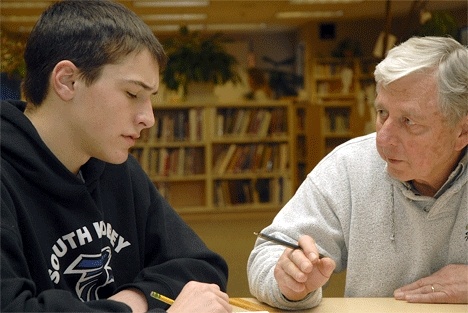LANGLEY — If Ann Johnson had her way, she would post “WANTED” posters throughout the South End.
The usual suspects would understand algebraic equations, verbs or the periodic table of elements.
The suspects wouldn’t be thrown in jail or fined, but rounded up and taken back to South Whidbey High School as tutors.
Johnson works six hours a week as Learning and Community Engagement Program’s tutoring coordinator at the high school and at Bayview School.
South Whidbey School District once had a robust tutoring program, Johnson said.
But along the way, numerous leadership changes fostered a lack of motivation and tutor recruitment suffered.
And then, tutoring simply fell off the community’s radar screen, Johnson said.
Students still need help, however.
“I have 10 tutors in one-on-one mentoring relationships with students right now,” she said. “But I have from 30 to
50 students at any one time who could use tutors.”
Johnson would like to see a core group of 30 to 35 tutors to help students with their math, science and English courses.
Students struggle with math courses the most, Johnson said.
“Math is the big one; all levels of math, especially Algebra 1 and 2 because they are the hardest-hit classes in the Washington Assessment of Student Learning,” she said.
Sophomore Daniel Childers agreed that math can be tough. He meets with Andy Plitkins of Freeland after school to boost his algebra skills.
“It helps me understand problems, algebraic equations,” he said. “Equations are difficult for me.”
Childers prefers the one-on-one time with Plitkins because he breaks it down to simple terms, he said.
In turn, Plitkins gets to see the epiphanies of understanding in the students he assists, he said.
“I enjoy seeing kids get it when they are having problems,” the math tutor said.
“I can usually spot problems and help them understand. It is very satisfying to be of help.”
Johnson has discovered that ninth-grade students seem to already be at a disadvantage when they first arrive at the high school.
“We found that sometimes ninth graders just aren’t ready for the rigor of some of the core classes,” Johnson said.
“So if they are in an English, science and math class, they are overwhelmed. Some kids need a little help with everything.”
Johnson has also found that the upper-classmen are not immune to needing assistance from tutors.
“Last semester, I had at least 30 referrals land on my desk; all kids, all ages,” she said.
A difficult part of Johnson’s job is telling parents of students who need help that while there is a tutoring program available, there aren’t enough tutors.
“It’s tough to call a parent and tell them we have this opportunity for their child, but that I don’t have anyone who can make that opportunity a reality,” Johnson said.
The costs to the student are high, she said. Grades suffer and skills are not learned.
“Students are not getting the help they need. Grades definitely become a challenge because, using math as an example, math is a progressive course,” she said.
“If they don’t understand ‘concept one’ at the beginning, then they definitely are not going to understand ‘concept 10’ weeks later.”
For some students, that leads to an ongoing struggle of playing catch-up.
The requirements to become a tutor are not stringent, Johnson said.
Tutors don’t need to have a teaching or education background but do need good people skills. But tutors also need to be flexible, Johnson said.
“They need to be able to adapt to how the subjects are taught versus how they were taught when the tutors were in school,” she said.
Tutors help form a vital link between parents, students, teachers and the community, Johnson said.
“Tutoring is necessary and valuable,” she said. “It blossoms into a mentorship and becomes an exchange of values and ideas. These are wise folks with amazing life experiences and creates a kind of intuition that allows the tutor to understand what the student needs.”



